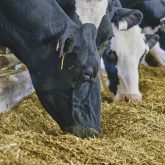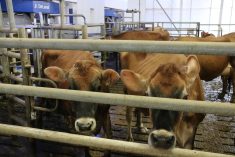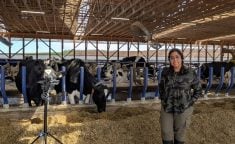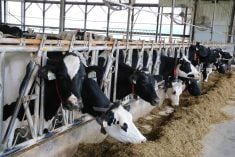Every farm transferred from one generation to the next charts its own path based on its unique challenges and opportunities.
For the dairy-farming Marshall family northwest of Woodstock, a lengthy assessment of those challenges and opportunities pointed the way to a soon-to-open on-farm processing facility and store.
Golspie Dairy recently gained mainstream media attention thanks to a plan to include a fresh milk vending machine in the on-farm store. However, cheesemaker Marja DeBoer-Marshall insists the biggest innovation is finding a way to continue a nearly 150-year family farm tradition without following the more commonly trod path of expanding land base and purchasing milk quota.
Read Also

Packer buys Green Giant, Le Sieur veg brands from U.S. owner
A Quebec-based processor’s deal to buy the Green Giant and Le Sieur packaged and frozen vegetable brands in Canada from a U.S. owner clarifies the status of two popular retail brands grown by Canadian farmers.
Why it matters: On-farm dairy processing is becoming more popular and can add an extra income stream for dairy farms.
“We probably started thinking about it about five to six years ago,” says DeBoer-Marshall. She and her husband, Laurence Marshall — who grew up on the farm with his parents Ron and Wendy — “were fresh out of university,” living in the farm’s second house, when they began figuring out how to carve a place for themselves in the business through a succession process that would give financial stability to the older and the younger generations.
At the time they were milking 32 registered Holsteins and DeBoer-Marshall says they realized they were selling a commodity. The well-established approach to improving the bottom line is to take advantage of economies of scale.
“But to try to grow our farm, just in terms of acreage or quota, was going to be very difficult at that time and would be even more so now,” she said. “It just didn’t pencil out in our case.”
They needed something other than greater farm size to backstop a strong financial case for potential lenders. An additional income stream, using value-added production, appeared to be the answer.
A resurgence of on-farm processing in Ontario, spurred in part by support programs through Dairy Farmers of Ontario and the government, was underway at that time. There were two success stories in their region already — Gunn’s Hill Cheese near Sweaburg and Mountainoak Cheese near New Hamburg.
“We just kept an eye on a lot of the things happening in the U.S. and Canada,” DeBoer-Marshall said.
She had been working for a local marketing communications agency, close to where the farm is located in the village of Golspie, but then took a job at Mountainoak Cheese. It allowed her to learn about cheesemaking without taking an established training program in the U.S. or Europe.
Those programs, she said, are “expensive, and to be away for that long just wasn’t going to work for me.”
It set in motion a plan to build an on-farm cheese plant at the Marshall farm. To get a processing license, their plan had to include cheeses that weren’t already available in the marketplace using Ontario milk. They settled on British cheeses similar to cheddar.
Meetings, paperwork and detailed planning began about 18 months ago to create a business plan and get financing, building permits and an OMAFRA dairy processing license.
It was originally going to be solely cheese but, once news got out that they were planning a processing plant, a dairy industry contact told them they didn’t need an additional license to process fluid milk. The family knew that, with the cheese plant, there would be a big up-front investment but the need to age the cheese before sale would delay a return on that investment.
Also, approximately 10 litres of milk are needed to make one kilogram of cheese. That limits the revenue per litre of milk from cheese unless it is a high-premium variety. With fluid, depending on the valued-added proposition for the consumer, on-farm processors typically sell for up to $5 per litre.
Selling fluid milk does bring its own challenges, DeBoer-Marshall noted. “It only lasts for so long and you have to figure out packaging for it. And it’s heavier.”
Nonetheless, “having fresh milk right away to fill in that gap (between making cheese and being able to market the aged product) seemed like a good idea…We figured it would be a fun transition to bring people to the farm right away.”
They had heard about fresh milk vending machines in Europe so they sought approval to introduce them to Canada. “Golspie Dairy” glass bottles are now being made, and vending machine customers will be able to use either a bottle from the store or their own suitable container.
The initial business plan, when full production commences, calls for use of about half the farm’s milk in the on-farm processing side. Between 20 and 30 per cent of that, they hope, will be sold as fluid milk either from the farm store or in the small independent businesses that they’re seeking as retail outlets for milk and cheese.
“But we’ve had a lot of positive responses to the news about the milk, so who knows?”
The plant and store, which are adjoining, are under construction a few hundred feet from the tie-stall dairy barn. A custom-built milk hauling trailer will take their milk from the barn to the processing plant.
“I’ve been referring to myself as cheesemaker and chief operating officer,” DeBoer-Marshall said. But it has been a family effort.
“We all have different strengths that we draw on. It’s nice to have such a great team to work with.”
As a smaller dairy farm, it was tough at times to put forward a strong business case for potential lenders. The established on-farm processors in Ontario tended to be much larger.

For the Golspie Dairy team, “we really had to look at any and all options… We had to look at so many different possibilities of what the future would look like on our farm.”
DeBoer-Marshall doesn’t believe there’s less risk in deciding to process on the farm compared to the risk of expanding land and quota if they could get it.
“It’s just that it’s something that we thought we could be creative with in order to manage that risk.”













